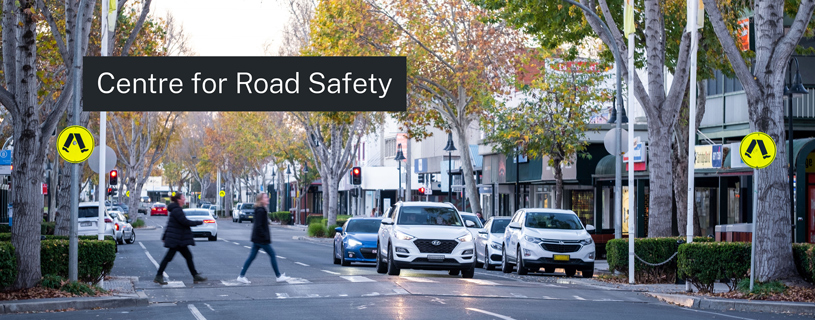Average speed cameras
Speeding is the biggest killer on NSW roads, contributing to around 42% of all fatalities. Every year, 128 families, as well as friends and communities lose someone in a road crash where speeding was a contributing factor.
In September 2024, the NSW Government announced a trial to expand average speed cameras from heavy vehicles to light vehicles. This includes cars, motorcycles and utes.
All other mainland Australian states and the ACT use average speed cameras for heavy and light vehicles as part of their speed enforcement programs. Previously, only heavy vehicles were detected by average speed cameras in NSW.
Light vehicle trial
From 1 May 2025 until 30 June 2026, a trial is being conducted in two separate locations on limited stretches of highway in regional NSW to assess whether these measures reduce speeding at these locations, improving safety and preventing injuries and fatalities. The trial areas are:
- Pacific Highway between Kew and Lake Innes (Port Macquarie) – 15kms between cameras
- Hume Highway between Coolac and Gundagai – 16kms between cameras.

The trial began on 1 May with a two-month warning period that ended on 30 June 2025. From 1 July 2025, all speeding offences will be enforced by the average speed cameras.
Light vehicle compliance rates from 1 May 2025 to 30 June 2025 (Warning letter period) are listed in our Average speed camera trial – data snapshot May-June 2025 (PDF, 155.55 KB).
Light vehicle compliance rates from 1 July 2025 to 31 August 2025 are listed in our Average speed camera trial – data snapshot July-August 2025 (PDF, 159.06 KB).
Average speed camera penalties for light vehicles are the same as the penalties for other speeding offences by light vehicles. All speeding fines in NSW (including from the Average Speed Camera Trial) are allocated to the Community Road Safety Fund and used solely to improve road safety in NSW.
Heavy vehicle average speed enforcement will continue with no change at both locations.
Heavy vehicles
Since 2010 average speed cameras have been used to detect speeding in heavy vehicles and trailers with a gross vehicle mass greater than 4.5 tonnes.
There are currently 25 average speed enforcement lengths in regional NSW and 7 average speed enforcement lengths in the Sydney Metropolitan area. These average speed enforcement lengths are on known heavy vehicle routes that have an over-representation of heavy vehicle crashes.
Average speed enforcement lengths are selected using criteria developed by Transport for NSW. Site selection is based on several factors including the frequency and severity of heavy vehicle crashes, heavy vehicle speeds and road conditions.
In the 25 regional locations where average speed cameras are currently operating there has been a 44% reduction in deaths from crashes involving heavy vehicles.
The two light vehicle trials are located on existing heavy vehicle average speed enforcement lengths.
Average speed enforcement is used to enforce existing speeding laws. For heavy vehicles an additional demerit point is incurred by any heavy vehicle driver detected speeding by average speed enforcement, as it shows a continued intention to speed.
Find out more on the NSW Government website about offences and penalties.
How average speed cameras work
Image
Image controls:
Average speed cameras use two cameras to measure the amount of time it takes a vehicle to travel between two points on a stretch of road. A time-stamped image is taken as the vehicle passes each camera. The vehicle’s average speed between the two cameras is then calculated. If the vehicle’s average speed exceeds the speed limit for the length of road, the driver or rider will receive a penalty for speeding.
All average speed enforcement lengths are certified by a registered land surveyor to ensure the distance between the cameras is accurate. The distance is used to calculate a vehicle’s average speed across an average speed camera length and is the shortest possible distance, so there's no possibility for a driver’s speed to be overestimated.
Other languages
Our translations allow diverse communities to find out how average speed cameras work, their safety benefits and where the light vehicle trial operates in regional NSW. Find the translations at Other languages - average speed cameras.
Your speed decides the outcome
Speeding is never safe. Increasing your speed, even by just a few kilometres per hour, can significantly increase the risk of death or serious injury to yourself or others. As your speed increases, your chance of being involved in a serious crash increases, while the chances of surviving a crash decreases.
The human body can only tolerate a certain amount of force. In a crash, the faster you crash the greater the force on your body. This is why small decreases in your speed have such a large impact on crash severity.
The faster you go, the greater your risk of a crash
As speed increases, so does the likelihood of serious injury or death. This is because:
- the driver has less time to react to a hazard
- the distance travelled while you respond is greater
- the distance travelled before coming to a stop is greater
- the speed upon impact is greater.
The combined effects of reaction and braking times in both wet and dry conditions is shown below.
How you can keep safe
- Regularly check your speed to ensure you are within the posted speed limit. The Speed Adviser smartphone app can help by announcing the speed limit on all NSW roads and alerting you when the speed limit changes.
- Follow speed advisory signs. This will help ensure you drive through that section of road safely.
- Keep a safe distance between you and the vehicle in front. When travelling behind a light vehicle leave at least a three-second gap, and for heavy vehicles leave at least a four-second gap. When travelling at higher speeds, increase the distance to allow at least five seconds so you have enough time to react and brake.
- In poor conditions (such as wet weather, snow or fog) drive slower and leave a larger gap between you and the vehicle in front.
- Allow yourself plenty of travel time, including time for rest breaks, so you don’t feel the need to speed.
- If you’re a passenger, speak up if you think the driver is going too fast.
Frequently asked questions
Was there a warning period for the new average speed camera trial?
Yes, the trial started in warning mode for two months. From 1 May until 30 June 2025, warning letters were sent to speeding drivers to encourage a positive change in their driving behaviour.
As of 1 July 2025, all speeding offences are being enforced by the average speed cameras for the duration of the trial.
Are average speed enforcement lengths signposted?
Yes. In regional locations there’s one advance warning sign on each approach that displays a camera image and the text “AVERAGE SPEED SAFETY CAMERA”. On metropolitan motorways the same type of signage will be used along the motorway to indicate the presence of average speed enforcement.
On the approach to tunnels where average speed cameras are used, signage will not change, there is already advanced warning that speed cameras are used in tunnels.
How is privacy protected?
Transport and Revenue NSW have strict obligations to ensure the personal information of NSW road users is protected in accordance with statutory requirements. We continue to consult the NSW Privacy Commissioner to ensure compliance with privacy principles.
The program ensures only the minimum amount of data required to detect and enforce offences is retained. In common with all NSW traffic camera enforcement systems, strict data security measures are included in the scope of requirements for the program.
What does the camera record?
Average speed cameras record photographs of vehicles as they pass the start and end points of an enforcement length. The cameras also record the licence plate of the vehicle and the exact time the camera took the photograph.
Can police enforce speeding or other offences in average speed enforcement lengths?
It is not intended that average speed enforcement replaces police enforcement on average speed enforcement lengths. Police enforce a wide range of offences, including speeding, and for the safety of road users it is necessary that this enforcement continues in average speed enforcement lengths. Speeding infringements and suspensions issued by police will continue to apply regardless of whether the driver also receives a speeding infringement from the average speed enforcement camera.
Can average speed technology enforce speeding where there are multiple speed limits on an average speed enforcement length?
Average speed enforcement lengths enforce the sign-posted speed limit along that length. Where there are multiple posted speed limits, the ‘average speed limit’ will be calculated using a legislated formula. The formula takes into account each speed limit and the distance each speed limit applies to.
How do we know average speed enforcement technology is accurate?
Average speed cameras are subject to rigorous testing and certification in accordance with legislated requirements. Transport for NSW has developed strict operational guidelines for average speed cameras to ensure that they are robust and accurate. The distance used when calculating a vehicle’s average speed across an average speed enforcement length is the shortest practicable distance, which ensures that there is no possibility that a driver’s speed can be overestimated.
What can I do if I’m issued a penalty notice but don’t believe I committed an offence?
You can ask Revenue NSW to review the infringement. You can request a review on the Revenue NSW website. If you were not driving the vehicle at the time of the offence you can nominate the person responsible for the offence.
If Revenue NSW decides the penalty notice should stand, you can apply through Revenue NSW to have the matter determined by a magistrate in the NSW Local Court.
More information
Speeding is the single biggest killer on NSW roads, contributing to about 40% of fatalities each year.
Our driver’s aid app helps manage your speed by providing visual and audible warnings if you exceed the speed limit.
Use this page to tell us where you think enforcement cameras should be located in NSW. Your submission will be reviewed by road safety experts.
Speed limits are set to manage the risk of crashes and minimise the forces that road users are exposed to, helping to reduce serious injuries and fatalties.




